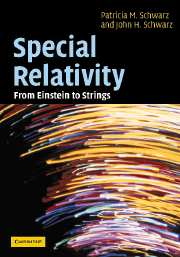Book contents
- Frontmatter
- Contents
- Preface
- Part I Fundamentals
- 1 From Pythagoras to spacetime geometry
- 2 Light surprises everyone
- 3 Elements of spacetime geometry
- 4 Mechanics in spacetime
- 5 Spacetime physics of fields
- 6 Causality and relativity
- Part II Advanced Topics
- Appendix 1 Where do equations of motion come from?
- Appendix 2 Basic group theory
- Appendix 3 Lie groups and Lie algebras
- Appendix 4 The structure of super Lie algebras
- References
- Index
6 - Causality and relativity
Published online by Cambridge University Press: 06 July 2010
- Frontmatter
- Contents
- Preface
- Part I Fundamentals
- 1 From Pythagoras to spacetime geometry
- 2 Light surprises everyone
- 3 Elements of spacetime geometry
- 4 Mechanics in spacetime
- 5 Spacetime physics of fields
- 6 Causality and relativity
- Part II Advanced Topics
- Appendix 1 Where do equations of motion come from?
- Appendix 2 Basic group theory
- Appendix 3 Lie groups and Lie algebras
- Appendix 4 The structure of super Lie algebras
- References
- Index
Summary
Hands-on exercise
Make a two-dimensional coordinate grid on a piece of heavyweight paper that is stiff enough to bend into a circle without folding over. Make a time axis labeled τ and a space axis labeled x, with the origin of the coordinate system in the center of the sheet. Pick a direction on the τ axis to be the direction of increasing τ and label it.
Roll the paper into a cylinder with the x axis running lengthwise and lightly tape it shut. The circular axis should be the τ axis. Using a marking pen, draw two null lines starting the origin, towards the direction of increasing τ, which should be 45° lines in the (τ, x) grid. Draw a timelike line in one direction, starting at the origin. Keep drawing the lines around the cylinder until the end of the paper in both directions. Untape the paper and unroll it. Is there any area on this diagram that cannot be reached from the origin by a future-directed timelike or null world line? Is there any difference between the past and the future light cone of an event in such a spacetime? Are there any two events in this spacetime that cannot be connected by a null or timelike path?
What is time?
Flat spacetime appears on its face to be very simple. We have space in the form of D coordinates (x1, …, xD) and time in the form of the τ coordinate, and we have Lorentz transformations between the two.
- Type
- Chapter
- Information
- Special RelativityFrom Einstein to Strings, pp. 197 - 218Publisher: Cambridge University PressPrint publication year: 2004



